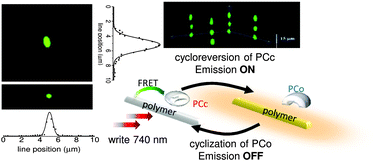A 1,3,5-triazine based polymer as a nonlinear near-infrared antenna for two-photon activated volumetric optical memory devices†
Abstract
The ability of a 1,3,5-triazine based polymer to work as a nonlinear near-infrared (NIR) antenna in functional optical materials is discussed. The push–pull polymer is composed of alternating electron acceptor cores of 2,4,6-tris(thiophen-2-yl)-1,3,5-triazine, bridged by electron donor groups of 9,9-dihexyl-9H-fluorene. It has been tailored for high two-photon absorption and efficient up-conversion of the excitation energy into fluorescence emission. These properties are here explored in the operation of prototypical storage material for volumetric nonlinear optical memory devices. Multilayer data storage is demonstrated in composite films of photochromic (PC) molecules doped with the polymer. The two-photon excitation of the polymer triggers a unidirectional isomerization of the PC molecules (a cycloreversion process from the closed to the open isomer) via Förster resonant energy transfer. Data recording with as little as 1 ms of exposure time and 1 mW of 740 nm radiation is accomplished.



 Please wait while we load your content...
Please wait while we load your content...